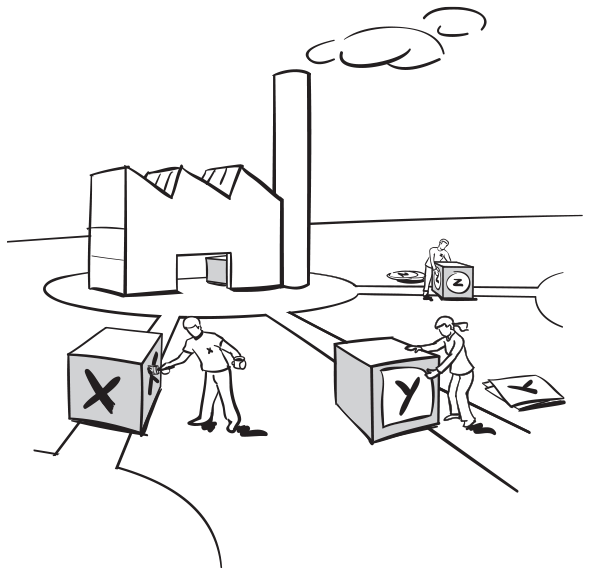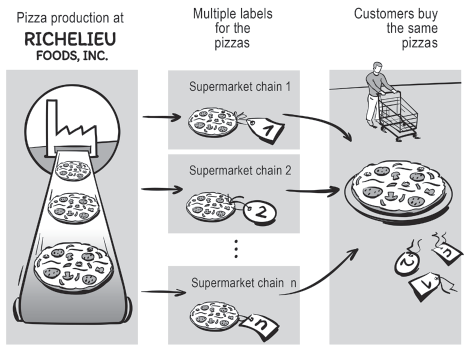White Label
No brand as strategy

The pattern
White Label goods are not given a specific name after being manufactured but are sold by different companies under different names and in different market segments (WHAT?). Producers of White Label goods bear only the product manufacturing costs: this is a significant advantage of this business model, because it obviates the need to invest in infrastructure (HOW?). The White Label company focuses on optimising production processes and will therefore have a better chance of generating economies of scale. Since the finished products have not been branded, vendors can market them in whatever way they choose. White Labels can also be used to sell a section of a company’s products under a different brand name. This is commonplace in the food industry, where products may be manufactured at one facility, packaged in various ways and sold by retailers under different names (HOW?, WHAT?).

Revenues generated with the sale of no-name goods can supplement those from branded products. This opens up access for the business to lower-income customers and alternative distribution channels. In addition, production will be more efficient if it is possible to reach customers with differing product-quality expectations. Often, very little extra work will be needed in order to supply these additional customers, since all the goods are based on the same basic product. For the White Label business model to work, it is important that customers do not realise that ostensibly different offerings are actually the same; otherwise sales of the pricier brand are likely to be eroded or cannibalised by the cheaper substitution product.
The origins
The music industry first invented the term ‘White Label’ and propagated it during the second half of the 20th century. Artists frequently sent unlabelled demos to radio stations and clubs before officially releasing their CDs and LPs. These demos bore the name of neither the record label nor the artist, hence the designation ‘white label’. This served two main purposes: first, to attract new listeners to an artist’s sound, and, second, to ensure that listeners were not prejudiced, thus enabling the record labels to estimate production quantities more accurately. If albums were well received, they were officially released, adorned with a proper label and given professional marketing. Other industries, the food industry especially, later adopted similar methods. A familiar feature in the food industry is the presence of comparatively small margins over substantial sales volumes. This is conducive to application of the White Label business model.
The innovators
Taiwanese technology company Foxconn is perhaps the biggest and most famous White Label innovator, as it manufactures many electronic devices and components for well-known brands. Reputable companies including Apple, Dell and Intel are among its customers. Regardless of whether a console is labelled Microsoft, Nintendo or Sony, it will contain at least some Foxconn hardware. Surprisingly too, the company is even the leading manufacturer of central processing units (CPUs) and computer casings. All of this makes Foxconn a prime example of what constitutes a White Label producer. As a contractor, the company focuses wholly on producing electronics. In this way, the contracting companies benefit from its consistent and cost-effective production and are able to concentrate on research, marketing and branding. This principle has enabled Foxconn to build considerable expertise in the industry. The company employs almost 700,000 workers and generated revenues in excess of US $175 billion in 2018.
CEWE follows the White Label logic for its photo printing services (e.g. photo books), which are presented as products of the selling distributor or supermarket. While this was a major driver for own growth, this business model also allowed access to various sales channels, even of direct competitors (e.g. Rossmann and DM). Applying the White Label pattern helped CEWE to enter the market, become acquainted with high-quality products and build up a well-recognised brand name that made them a leading player in their respective industry. From this, CEWE could then apply the Ingredient Branding pattern (#22) in parallel to their White Label approach, to further strengthen their market position.
White Label producers are also well established and highly innovative in the food industry. Richelieu Foods is a famous White Label contract food producer of frozen pizzas and salad dressings. The company’s products are marketed and sold under the brands of various retail chains. Customisation of manufacturing processes and packing options by Richlieu Foods for the contracting client enables the latter to benefit from consistently high-quality products that they can brand with their own label without the costs associated with establishing manufacturing and packaging facilities. As discount stores have gained market power, the White Label concept has obtained a strong foothold in food retailing. No-name and store-brand products make up more than two-thirds of all goods sold in the food industry. These developments explain the continued steady growth of White Label producers.
The White Label pattern is also applied in the financial industry. Because of a lack of economies of scale, smaller banks outsource financial services to larger institutions such as credit card companies. Not apparent to the customer, the partner institution issues and processes the credit cards as White Label cards, in exchange for a fee. Allowing the smaller banks to brand the cards as their own saves the banks the costly background infrastructure. For instance, Sydney-based company Cuscal provides such a service to credit unions across Australia.
When and how to apply White Label
You may choose to opt for a White Label strategy if your customers are very price sensitive and you already have a firmly established brand. This business model has been applied very successfully in both the food and garment industries in the past. To start with, you will most likely want to introduce only a limited number of White Label products.
Some questions to ask
- Can we handle any conflicts with premium-brand products if we sell them as White Label products?
- How do customers perceive the value of our products?
- Do we have a cost advantage due to lack of own-branding strategy?
- What can we learn and how can we benefit from our current premium brands if we wish to create White Label products?

